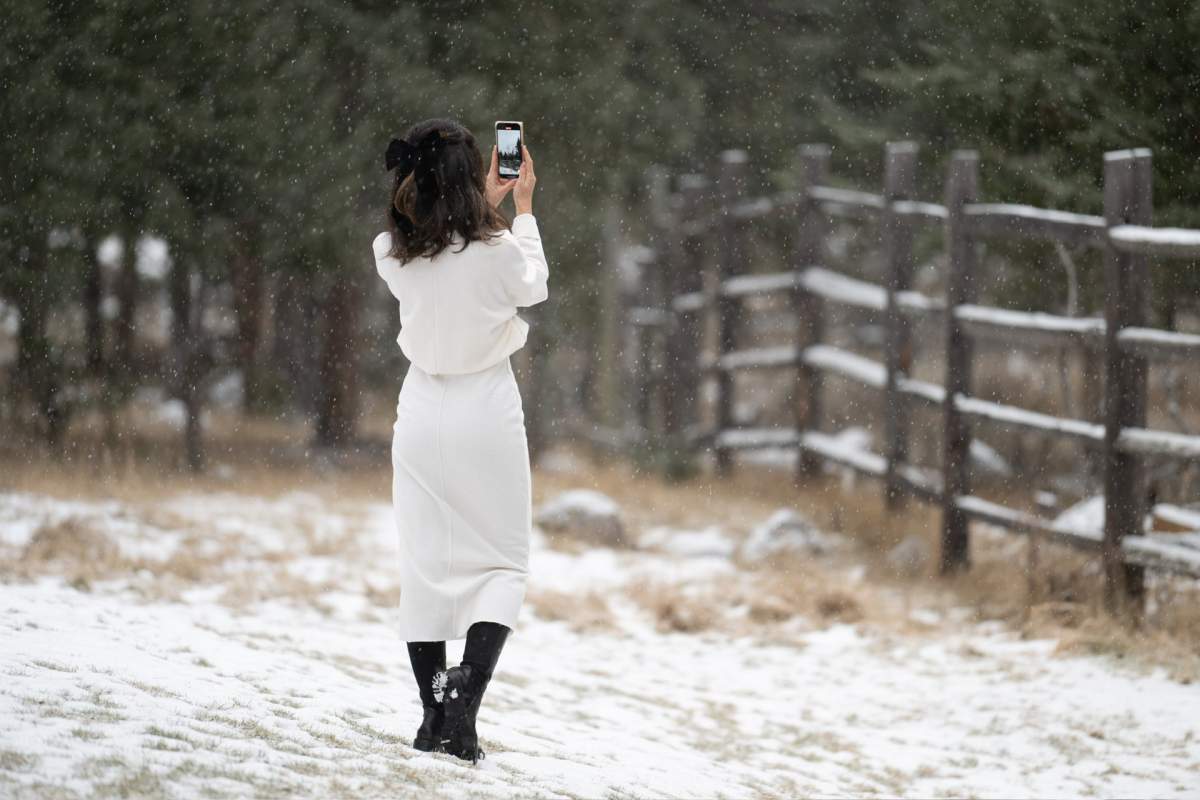On a sunny winter morning inside a bustling downtown Calgary café minimally decorated to exude a clean contemporary aesthetic, social media influencer Nafsa Karwani meticulously arranges her latte and pastry for a thoughtfully curated social media post.

On the same day, atop a snow-deprived mountain in Jasper, Influencer Jasmine Shannon, known online as Lemons for Days, is on a luxury brand trip with her family at a Fairmont hotel.
“I really didn’t think I would be making six figures doing this,” said Shannon. “It was interesting to me that I can make three times as much as I was making working downtown at a corporate consulting job. My lifestyle is wonderful and sky’s the limit, but you must work for it.”
Influencer marketing is an online strategy where brands collaborate with social media influencers or celebrities that have a substantial, engaged presence on various platforms like Instagram and YouTube to promote products or services. Brands often prefer influencers over traditional methods of advertising like billboards or commercials because they have immediate access to a target audience.
A 2023 report from Statista says the worldwide influencer marketing industry is worth nearly US$21.1 billion and has increased 105 per cent since 2021 when the market was valued at $10.29 billion.
With 4.95 billion people in the world on social media as of October 2023, which is 61.4 per cent of the total global population, influencers have no shortage of customers to pitch to, and despite uncertain economic times the future landscape of influencer marketing is bright. Between 2023 and 2030, the industry is projected to flourish at a compound annual growth rate (CAGR) of 33 per cent.
The Hub Spot 2023 State of Marketing Report says the greatest return on investment (ROI) for marketers are blogs, social media shopping tools, and influencer marketing.
As a Nano Influencer with 2,575 followers on Instagram, Karwani’s goal is to land paid partnerships with skincare, makeup and fashion brands and monetize her content.
“I do my best to connect with my audience by sharing affordable fashion and skincare products that resonate with the current economic climate,” she said.
“Discoverability is tough. Influencing is something that a lot of people are getting into. It’s a wave. With many people entering the market it’s becoming more competitive, that puts a lot of pressure on me to create quality content that is relatable and shareable. Those are the main things that platforms like Instagram would use as a metric in terms of content that the algorithm will push.”
Brands prefer to work with macro and mid-tier influencers for their campaigns over celebrities, due to influencer’s high engagement, which is the percentage of their viewers who follow, like, share and comment on their content.
Sitting at 47.7K followers, Jasmine Shannon is considered a power or mid-tier influencer and her goal this year is to trade paid posts with products for tourism influencer marketing and travel experiences with hotels and unique destinations that are visually striking.
“My intention is to write and post as though I’m talking to my best friend. I want it to be casual and super chill,” said Shannon.
“Because I started seven years ago, I got in at a good time. I’ve had the privilege of building trust and I know how to hone in on what speaks to my audience. Competition in this space can be scary, but no two people are the same. If you’re authentic you’ll stand out,” said Shannon.

Get weekly money news
To help newcomers stand out in the often-saturated industry of influencing, celebrity manager and talent agent David Weintraub released The Hollywood Handbook, which is a seven-course series about how to break into music, television and social media.
Weintraub’s repertoire of A-list clients include Harrison Ford, Mike Tyson, Justin Timberlake, Kim Kardashian, Eminem, Gwen Stefani, Chuck Lidell and Ray J, his Basics of Influencing course breaks down what your content path could be.
“We teach you how to come up with your ideas, how to create and shoot your content and how to distribute it,” says Weintraub. “In The Hollywood Handbook we teach you some tricks about what you can do to go viral and how to expand your viral ability and get out there and make your moment. Usually from there, that’s when brands and opportunities come, TV companies want to work with you, brands want to hire you to post. There is a lot of different ways you can do it, and with my 20 plus years of experience we can do what we did with Scott Disick, Ray J, and the kids from Laguna Beach and the Hills and Brody Jenner.”
In the late 1990s, an internship at Interscope records was Weintraub’s soft launch into Hollywood. While pursuing a business degree at USC he also worked at Death Row Records in its heyday. As an A&R rep, he recruited talent from his arsenal of talented friends in Los Angeles. When his friend discovered an emerging rapper in the motor city named Eminem, he left to help launch the legendary career that included music, films and countless awards.
When the non-scripted television boom hit in the early 2000s, Weintraub recruited and signed deals with his famous friends including Paris Hilton, Nicole Ritchie, the cast from The Hills and the Osbornes to name a few. He helped build the billion-dollar Kardashian family, and created and executive produced his own reality show called Sons of Hollywood for A&E.
“It was like a reality Entourage, it starred myself and my two best friends that I grew up with Sean Stewart, Rod Stewart’s son, and Randy Spelling who’s Aaron Spelling’s son,” he said.
His first big hit was co-creating Celebrity Rehab with Dr. Drew that ran for 10 seasons. He went on to create and produce shows and content for Bravo, MTV, VH1, Fox and Netflix totalling over 2,000 hours of television in his career.
While signing rock stars, rappers, and reality stars to his company DWE Talent, he noticed that social media presented an opportunity for monetization, so Weintraub started brokering lucrative deals for his A-list and controversial clients and now social media is a key part of his representation business.
“You now have people that were famous for being famous or famous for being on the internet and we started to lean in more into making money with people that weren’t your prototypical stars,” said Weintraub. “That was the early side of what influencing became because the first influencers are from a generation of growing up on reality TV shows, and then having the ability to make their own content on their phones at home on their computer. You have this ability to create your own narrative and as that narrative becomes bigger and bigger, and the likes, comments, retweets and the reach get bigger, that’s when the brands come in, and that’s when the money can be made.”
https://www.instagram.com/p/C1aD68IPG-9/?utm_source=ig_web_copy_link&igsh=MzRlODBiNWFlZA==
To work with this Hollywood powerhouse you don’t have to have a huge following, a famous last name or supermodel looks, Weintraub says it’s about being interesting, having talent, and a unique voice.
“Let’s say you’re an incredible baker, mechanic, or hair nail and makeup artist, everything that you’re doing on your videos has to have a unique style and look. Be loud, be different and always have an extreme point of view. Your point of view is what is going to draw people in, that’s what makes people want to be a part of your world. Two influencers that we work with, Trisha Paytas and Tana Mongeau, they are outspoken female influencers who have both reached over a billion in audience and they have this new fresh take on everything in the world and because what they say is completely unfiltered everybody gravitates to it.”
Weintraub strives for what he describes as water-cooler moments, that go viral and garner attention from the press and says having the finest looking content, with the best curated imaging will attract attention and investments from big brands.
“A lot of influencers at all different levels want to cross over to the film and television world and that’s our expertise, taking a YouTube star and turning them into a mainstream television star,” said Weintraub. “A show I executive produced and starred in, we did over 70 episodes called the Hollywood Hillbillies. We proved that we can do it. We took “the Angry Ginger”, Michael Kittrel, and we moved him to LA with his big farm family. They immersed themselves in the world of hip hop. I got him a record deal and we documented that over 60 plus episodes on Reelz of what it was like for me to represent an influencer reality star YouTuber and it was really funny and amazing.”
His recommends Micro and Nano Influencers that want to align themselves with major brands seek marketing agency representatives.
“Get in with them. Submit your content, get evaluated, show your best work and hopefully the agency can help you to get a lot more work. If you are a micro influencer and you see brands you want to work with or you see other influencers that are working with those brands you can submit your own analytic or inquiry to these brands or you can get with a company like mine and if you’re at a certain stature we would be interested in taking on the management role and help you get to the next level.”
https://www.instagram.com/reel/CvtGCuQJXT8/?utm_source=ig_web_copy_link&igsh=MzRlODBiNWFlZA==
While Nafsa Karwani strives to reach the next level in her influencing career, she says she’s not quitting her 9-5 as a marketing strategist at a digital marketing agency.
“Diversification is key,” says Karwani. “I plan to expand my content across different platforms and engage in strategic collaborations that align with my audience. By showcasing proven engagement and a genuine connection with my followers I believe I will be able to attract brands seeking authentic representation. I only collaborate with brands that align with my values and genuinely benefit my followers and community. By showcasing the genuine impact of a product in my daily life, I use that to build trust and interest in branded content.”
Jasmine Shannon’s advice on monetizing social media content is creating user generated content (UGC) for brands.
“That’s a wonderful way to make money because the pressure is off you, and how your content performs because you’re making this content for the brand that they can use on their page,” said Shannon. “It is paid very reasonably and if you get good at it could turn into something quite lucrative for you. Also selling the rights to your photos. Say a brand hires you for UGC and then they purchase that licence off of you for however number of months or years, that’s a great way to make income. Hopefully Tik Tok’s creator fund comes to Canada. The subscription option on Instagram is another way to make money, you have a very personalized experience with just that group of people in your audience that paid to see that content. It makes me feel a lot more connected.”
Weintraub suggests lesser known influencers accept non-paid collaborations with brands that offer PR boxes with free products to review and post.
“People who are trying to cross over from micro influencer to regular influencer space, money can be tight,” he said. “Visibility equals opportunity so if you are promoting your visibility and your content on your social media, opportunities are going to come but at the same time not every opportunity is going to be a huge payday and you don’t do every opportunity because it’s a payday, you do it to have brand alignment, notoriety, and great PR profiles. There are lots of reasons to do it that doesn’t have to do with the dollar.”
“Hone in your craft, make sure your content is really crisp, looks good, edited right, tagged correctly and if you want to learn more about how to get in this game, go get the Hollywood Handbook and be a part of what our vision is and how we’ve done it time and time again with huge celebrities that we found that were not anywhere and turned them into huge stars.”
Karwani’s is striving for that level of success and says those trying break into influencing have to “get over being cringe”.
“Once you overcome that cringe phase you will find your tribe and build a community that shares the same values and interests,” she said. “You never know who’s watching. Most of the content I had doubts about posting are the ones that have helped me secure some brand deals, don’t doubt yourself, stay consistent and get over being cringe.”
In 2023, over 35 million Canadians spent an average of two hours and five minutes on social media everyday. Jasmine Shannon said everyone following influencers should remember not to compare their lives to online talent, which is easier said than done.
“There’s a lot of ebbs and flows, sometimes I get completely burnt out like after the Christmas season. Everything is a highlight reel, I’m not going to show you when my kids are melting down or when I’m late for an appointment, just know it does happen and life is not perfect like you see on social media,” said Shannon.
With the introduction of AI and automation the ever evolving industry of influencer marketing will continue to transform, providing unique opportunities for brands to expand their reach while influencers earn fame and money.
At a corner table in the café, after making the most of the interior design as a gorgeous backdrop to an Instagram post, Karwani responds to Instagram comments from followers and sends inquiry emails to her favourite brands in hopes of expanding her influencing career.
Meanwhile in the Rockies, once it finally started snowing in Jasper, Jasmine Shannon and her photographer husband saw it as an opportunity for a photo shoot, as her carefully curated evolution into a travel influencer unfolds with each new post.












Comments